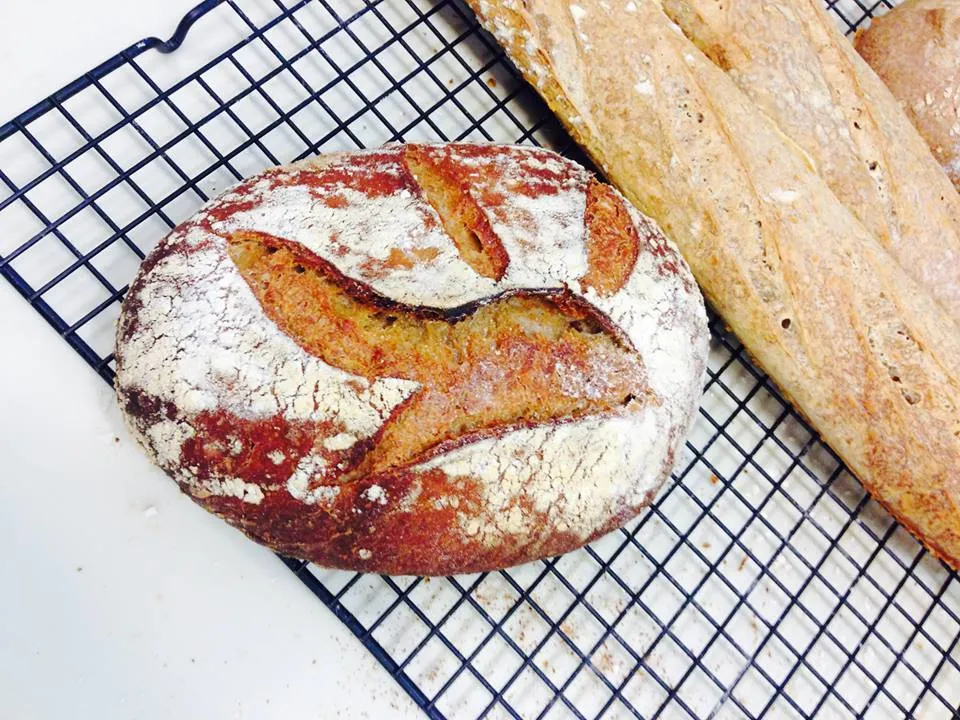
After 3 years of baking a number of breads from sources like Complete Book of Breads and Breadbaker's Apprentice, I stopped pulling the measuring gear, volume or weight, out of the cabinets when I set out to make bread. I use the same mixing bowl every time so that the visual information I receive is always in the same format, and then I bring together flours at my whim--KA AP, KA B, rye, whole wheat . . . and very recently the great -- GREAT -- line of flours from Castle Valley Mill in Doylestown PA. Truly great products. The image for this post is a loaf made completely with their flours. The one beside it is about one fifth KA AP or so.
Between my eyes, my taste buds, and my fingertips, we arrive at our desired colors and hydration. I almost never add anything beyond the flours, water, salt, and my home starter, nurtured with love. I do follow the ideas I have gleaned from many of you in my time reading this site--ideas about time and temperature, about steam and overnight refrigeration, about when to shape and how/when to introduce salt. I have learned a great deal from my place of silence here and I thank you for that.
While my method means I do not make the 'same' bread twice, the fact is that I have developed a sense of what I am looking for and so I am able to arrive within a narrow range, sometimes a bit more sour, sometimes a bit better crumb, but like a ceramic artist during the glaze fire: awaiting a surprise when I pull my loaves from the oven. Speaking of ovens: as a renter I was always at the mercy of the gas or electric that came with the house. For home baking, and short of my own brick oven that I will someday build, the gas oven I have now (and Electrolux Icon) is more than satisfactory in terms of heat and balance. As with most home ovens, steam is a continuing challenge.
I teach at a liberal arts college and this semester will teach a First Year Seminar on Bread. I am nervous about entering this subject (I am a Sculpture prof) but feel armed with the amazing wealth of information, history, myth, and culture surrounding this simple and magical staple. People regard bread making as a kind of alchemy, but you all know better than anyone that it is in fact more like gardening than like turning lead into gold. From the planting to the reaping to the milling to the building to the baking to the breaking . . . it asks that we tend it, that we attend to it, that we give it our attention. And so a note on my username--I love that bread is a thing that it is good to break, because when we break bread we repair ourselves to one another.
Happy Baking and Breaking -- Nestor
- bakers are such nice people's Blog
- Log in or register to post comments
Don't be like me .......weigh everything:-) You and your students will do fine after that. Pretty tough to teach the basic level one subject of bakers percent when you don't weigh anything and extremely difficult to craft recipes too, What you have learned here will put you in good stead.
Happy bread teahing
Thanks, dabrownman! I do find that oftener than not my own road to learning makes me more an anti-example than an example!
learn is what the dough feels and looks like at various points along the way. Touching, poking, stretching, patting etc are great ways to teach what it should look and feel like. The weighing is necessary and boring but the rest is the fun part. Making it fun and easy will make bread bakers for life. Making it boring and technical won't.
Happy SD bread teaching
I like your attitude and that you've taken the freedom and initiative to learn how to make bread the way you like it. Yes, your students will benefit from an abbreviated learning curve by weighing their ingredients and learning about what influences the finished bread. But, I suspect they'll also be encouraged to play and use their imaginations. That lesson is one they can take with them in all (most) parts of their lives, and it may be the lesson they remember most fondly.
But don't you lose that bowl!
Cathy
Cathy that bowl is treasure around my kitchen -- a cherished thing! In any case, I appreciate the encouragement. I can tell you that most of what we will do in the class involves research into the history, the politics, the poetry of bread -- but we will also be baking, of course!
I will recall your wisdom and dabrownman's -- measuring is a good way to start. It is certainly ow I worked for the first few years, anyway, and when I make a holiday sweet loaf or a traditional pumpernickel, I of course still rely on weights and measures... just not when I bake my 'daily' bread... Thanks for your words!
Your method of course has been used for centuries. Not everyone just pulls out their digital scale. I agree with you on the bigger message and it sounds like you are going to be teaching a very interesting class. Good luck!